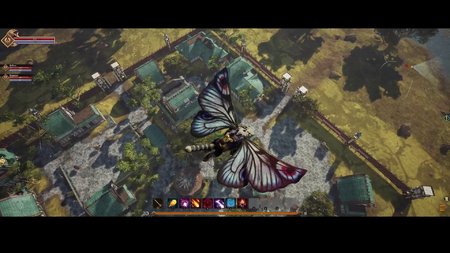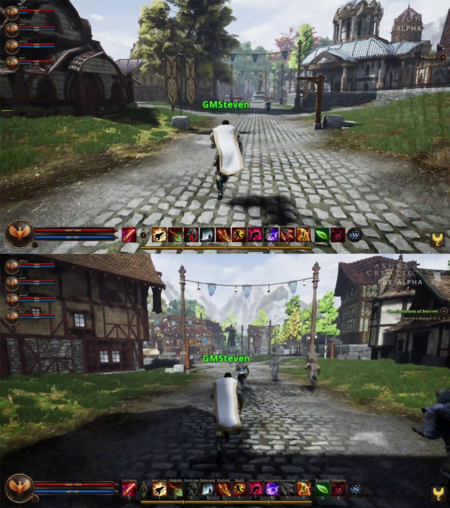Procedural generation
Ashes of Creation will predominantly have curated content, but procedural mechanics will be leveraged in a places where they don't appear to be 'procedural'.[1]
- Verra's map will not be procedurally generated, but starting resource points may be different on each server.[2][3]
- Node locations and types are predefined and are the same on each server but they will develop differently on each and drive different narratives and storylines.[4][3][5]
- Agencement et style des nœuds is determined by several factors, such as Environment (biome) and location, Node type, and Race.[6][7]
- Roads are both pre-generated and player influenced.[1][8]
Wherever we can leverage procedural mechanics in such a way that does not appear procedural we should. There's a healthy blend between the things that we do in having defined parameters for it and then incorporating a procedural component; and in that sense it will be perceived well, but where we the predominance of what we're implementing should be curated or by design.[1] – Steven Sharif
Roads

Our road system in-game is essentially driven by pre-placed routes that lead to this main artery of what was once the ancient highway system of Verra; and from there there are roads that become exposed when nodes advance; and we call those veins. They come off the main artery and then as nodes advance there are points of interest as Jeff was discussing earlier. These POIs that exist around the world and some of them share coverage with multiple nodes, but depending on which node advances to the stage that activates the point of interest it'll create these capillary roads so to speak that then stem off of the node itself. So you go from the main artery ancient road that's large- that runs through different zones and whatnot- and that breaks down into the veins that lead to the specific encampments and villages and towns that then spawn off separate capillaries that lead to the points of interest in these areas that are hunting grounds. Those are not exposed initially and they come online as players advance the world.[8] – Steven Sharif
As nodes advance, these pre-laid road spots that exist connecting every possible route between certain node structures is going to adjust and adapt, both its material presentation, the type of roadwork that's present: It'll move from dirt road type, to perhaps a brick road, to perhaps some super ornate beautiful metropolis style road that will adjust around the world according to how these node structures begin to populate and advance.[10] – Steven Sharif
Roads in Verra are both pre-generated and player influenced.[8]
- The largest roads are referred to as arteries. These are remnants of what was once the ancient highway system of Verra.[8]
- As nodes advance smaller roads, referred to as veins, connect the arteries to the nodes.[8]
- Depending on the stages of node advancement, capillary roads will stem off the node to connect to points of interest.[8]
- Roads or pathways are not worn into the landscape by repeated traffic over the same area.[8]
- The quality, safety, and maximum transportation speed of roads is influenced by node building upgrades, policies, relics, and the level of nearby nodes.[11][12][13]
- Q: Could you upgrade roads in the node to upgrade the roads and speeds of caravans?
- A: Absolutely. So that buff that you saw is a buff that can be changed in the world based on the world state. Some of those world state interactions include certain types of relics that the nodes which govern your area might have access to and might be actively employing. Some of it might have to do with policies: You might be able to extend the guard influences across the road radius further out for certain nodes if you have certain policies. You might be able to enhance and empower those guards through itemization choices that are granted by building upgrades that the node selects to build.[11] – Steven Sharif
Different seasons and events may affect access to various roads.[14][15][16][17]
- Pathways that are open during summer may be closed during winter.[14][17]
- Seasonal affects may cause obstacles or blockages to the transit of goods via caravan.[14][15][16][18]
- Caravan events can cause roadways to be blocked off or hostile mobs to spawn to attack the caravan.[9][15]
- Water turning to ice in winter, enabling players to walk over the water but blocking access to what is underneath.[17]
- Ice will make roads bumpy and slippery.[19]
Underrealm routes will open or close dynamically (based on node states).[20]
- The location of Underrealm entrances throughout the world is focused around natural geographic choke-points that exist above ground. This provides alternate subterranean routes that can be used by caravans, raids, and other player activities.[21][20]
- Not all entrances to the Underrealm will be open at the same time. This can shift dynamically (based on node states) that cause different routes to open up, which may be more or less advantageous than other routes.[20]
Caravan components can be utilized to improve on-road or off-road speeds of caravans.[22]
- You will travel faster over roads, but that obviously comes with the increased risk of running into other players or monsters that are blocking the road.[22] – Chris Justo
Propriété privée may not be placed in close proximity to roads.[23]
Agencement et style des nœuds

Même à la 3e étape de développement d'un village, l'agencement est plutôt de taille ; et la plupart de ces agencements incluent essentiellement des maisons statiques disponibles à l'achat pour les joueurs.[24] – Steven Sharif

L'agencement et l'architecture à l'intérieur des zones de développement d'un nœud sont déterminés par l'influence raciale. Par exemple, un Nœud à la 3e étape dont la majorité des contributions des joueurs étant Py’rai aura un village Py’rai avec une architecture Py’rai. La plupart des PNJs serait des elfes Py’rai, et offriraient des suites de quêtes concernant l'histoire des Py’rai.[4] – Margaret Krohn
Chaque expérience contribuée par les joueurs est marquée par la race de leurs personnages ainsi que d'autres identifiants. Lorsqu'un Nœud avance, la race avec la plus grande contribution d'expérience déterminera le style et la culture du Nœud. Un changement de style et de culture peut arriver à n'importe quelle étape d'un Nœud. Par exemple, si un Nœud avance au Niveau 2 - l'étape du Campement et que 51% de toute l'expérience a été gagnée par des joueurs Ren’Kai, le Nœud deviendra un Nœud de Niveau 2 Ren'Kai. Si ce même Nœud avance au niveau 3 - l'étape du Village, mais que les Py’Rai ont contribués à hauteur de 62% de l'expérience gagnée, le Nœud deviendra à ce moment-là un Nœud Py’Rai de Niveau 3. Les influences culturelles apportent plus que de simple changement esthétique ou des changements narratif - des bénéfices sont également accordés à la culture dominante à l'intérieur de la zone d'influence du nœud.[26] – Margaret Krohn
L'agencement des noeuds et le style sont déterminés par plusieurs facteurs :[7]
- L'Emplacement du nœud.[7]
- Les types de noeuds.[7]
- La race qui a contribuée le plus à l'acancement de noeud.[7][27]
- L'Apparence raciale des bâtiments d'un nœud ainsi que les PNJs.[28][27]
- Ceci s'applique à tous les autres nœuds, incluant également les nœuds châteaux.[29]
- Le reste est déterminé par le maire du Nœud.[7]
Certaines parties sont déterminées par la zone. D'autres sont déterminés par le type. D'autres par la race ; et le reste est déterminé par le maire.[7] – Jeffrey Bard
Tous les nœuds, qu'ils soient associés avec un château ou associés avec une structure de nœud normale, ont des influences culturelles qui se réplique sur les bâtiments qui sont produits et les PNJs qui sont présents.[29] – Steven Sharif
Il existe une mécanique d'usure qui affecte l'expérience et l'influence pour réduire les chances qu'une race domine le monde entièrement.[30]
Il y a de l'usure et cette usure sur l'expérience et l'influence augmente en fonction des performances d'une race dans le monde. Donc si tous les nœuds appartiennent aux orcs leur taux d'usure est très élevé pour rivaliser avec l'établissement d'autres cultures dans les nouveaux nœuds car ils ont plus d'influence dans le monde et l'opinion populaire est contre leur expansion dans les régions éloignées où ils n'ont pas assez d'influence.[30] – Steven Sharif
World manager
Le World manager est un algorithme dans Ashes of Creation qui contrôle les éléments dynamiques du monde. Il agit à la fois en tant que régulateur et en tant que système de récompense / motivation pour des activités variées en s'assurant que certains paramètres atteignent des paliers acceptables.[31]
- Le Prix des certificats de chasse.[32]
- Une carte de chaleur d'expérience gagnée à appliquer à l'avancement de Nœud.[32]
- Le Transit de ressources et de produits entre les régions pour diriger les récompenses de Quêtes des Nœuds.[32]
Par exemple si vous êtes au courant que le fer est utilisé en tant que matériau brut pour une construction spécifique qui pourra augmenter le prix du mithril ou de l'argent ; cela influencera le marché à corriger sa direction légèrement. L'idée générale est de fournir des motivations légères qui aideront à réduire la demande et également à fournir une ressource qui ne serait plus présente dans le système économique.[32] – Steven Sharif
Voir également
Les références
- ↑ 1.0 1.1 1.2 Direct, 2022-02-25 (1:07:36).
- ↑

- ↑ 3.0 3.1 Direct, 2017-05-19 (37:03).
- ↑ 4.0 4.1 Blog - Know Your Nodes - The Basics.
- ↑ A reactive world - Nodes.
- ↑ Direct, 2020-10-30 (39:17).
- ↑ 7.0 7.1 7.2 7.3 7.4 7.5 7.6 Direct, 2018-09-27 (53:06).
- ↑ 8.0 8.1 8.2 8.3 8.4 8.5 8.6 Direct, 2021-01-29 (1:13:04).
- ↑ 9.0 9.1 9.2 Vidéo, 2023-10-31 (34:12).
- ↑ 10.0 10.1 Direct, 2022-01-28 (33:25).
- ↑ 11.0 11.1 Direct, 2023-10-31 (1:16:34).
- ↑ Vidéo, 2023-10-31 (28:06).
- ↑ Direct, 2018-02-09 (45:48).
- ↑ 14.0 14.1 14.2 14.3 Vidéo, 2022-05-27 (15:50).
- ↑ 15.0 15.1 15.2 Podcast, 2021-04-11 (23:36).
- ↑ 16.0 16.1 Direct, 2020-06-26 (1:29:06).
- ↑ 17.0 17.1 17.2 17.3 Direct, 2017-05-08 (20:27).
- ↑ Our immersive world - Environments.
- ↑

- ↑ 20.0 20.1 20.2 Direct, 2020-10-30 (1:19:13).
- ↑ Direct, 2022-08-26 (53:26).
- ↑ 22.0 22.1 Vidéo, 2023-10-31 (20:17).
- ↑ Direct, 2017-05-19 (32:23).
- ↑ 24.0 24.1 Direct, 2020-06-26 (45:32).
- ↑ Direct, 2018-02-09 (33:50).
- ↑ Blog - Know Your Nodes - Advance and Destroy.
- ↑ 27.0 27.1 Entrevue, 2018-05-11 (54:34).
- ↑ Direct, 2017-05-26 (21:23).
- ↑ 29.0 29.1 Entrevue, 2018-05-11 (47:27).
- ↑ 30.0 30.1 Entrevue, 2018-05-11 (1:00:19).
- ↑ Entrevue, 2020-07-19 (1:10:55).
- ↑ 32.0 32.1 32.2 32.3 Entrevue, 2020-07-19 (1:08:22).